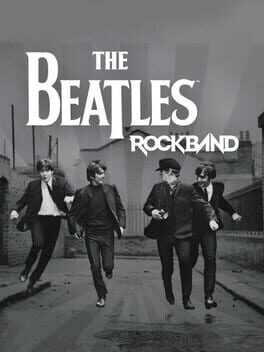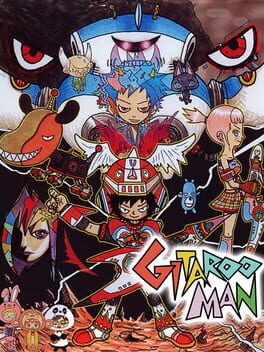ROSS FOUBISTER
DATE OF BIRTH: 12/08/1987
HEIGHT: 6"0'
BLOOD TYPE: [UNKNOWN]
Badges

Famous
Gained 100+ followers

GOTY '23
Participated in the 2023 Game of the Year Event

1 Years of Service
Being part of the Backloggd community for 1 year

Early Access
Submitted feedback for a beta feature

Treasured
Gained 750+ total review likes

Pinged
Mentioned by another user

Trend Setter
Gained 50+ followers

Adored
Gained 300+ total review likes

GOTY '22
Participated in the 2022 Game of the Year Event

Donor
Liked 50+ reviews / lists

Organized
Created a list folder with 5+ lists

Elite Gamer
Played 500+ games

Listed
Created 10+ public lists

Loved
Gained 100+ total review likes

Popular
Gained 15+ followers

Gone Gold
Received 5+ likes on a review while featured on the front page

Best Friends
Become mutual friends with at least 3 others

Well Written
Gained 10+ likes on a single review

Liked
Gained 10+ total review likes

Gamer
Played 250+ games

N00b
Played 100+ games

Noticed
Gained 3+ followers
Favorite Games
632
Total Games Played
019
Played in 2024
000
Games Backloggd
Recently Played See More
Recently Reviewed See More
Emeraldia is a fairly typical-looking block-stacking puzzle game, but holy shit is it cute. These are some of the most lovable sprites I've ever seen. Though the gameplay only involves guiding falling blocks around the screen, Adventure Mode insists you're playing as a brave little dolphin called Mint, out to rescue his sea creature friends from the devil of the ocean, Jamir. The game looks really inviting, and the screen's constantly filled with messages from friendly fish, explaining the game to passing observers in the arcade, but it really feels too technical for its own good.
Blocks come down in L-shaped sets of three colours. If you match two colours by dropping them directly on top of each other, they'll both shatter, and later, break. If they're placed in an unbroken horizontal or diagonal line, you can use them for a chain reaction. Having blocks fall down in three parts at a time means you'll need to rely on chain reactions to earn more screen space. It can be a disarmingly tricky game, as each new block with a desirable colour will force another two unwanted colours on you too, and each placement feels like something of a compromise, but I find I do best when I play it like Puyo Puyo or Puzzle Fighter - attempting to assemble groups of colours without breaking them, in the hope they'll cause a big combo later down the line.
Emeraldia is split up into Normal Mode, Adventure Mode and Head-to-Head Play Mode. Despite the names, I think Adventure Mode seems much more like the main mode of the game. In it, you play through pre-made puzzle levels and attempt to free fish, trapped within the blocks. It's the cutest mode, with the most sense of character, and little story boxes every now and then. When you save a fish, there's a little digitised voiceclip that says "Thank you!". It's undoubtedly the mode that new players will want to try when they first come across an Emeraldia cabinet, but Mint's there on the main menu, recommending you start with Normal Mode. This strips out all sense of character that the game has, and just becomes an abstract block-stacking survival puzzle. You play until you fail, and there's no reward other than the potential to place on the high score screen, but it's the most direct way to understand the fundamentals and balance of the game. Then, there's Head-to-Head, which is just a 2-player versus mode with no option to play against a CPU. Despite how relatively small a part of the game Head-to-Head is, it defines the whole of the rest of the game, as you play everything in a little window to the left-hand side of the screen, with the right reserved for Player 2, who plays as a pink dolphin. I imagine a lot of players came to try for the first time, jumped into the two-player, didn't really know what they were doing, and walked away dissatisfied, looking for something that was actually fun.
That's the shame with this. I think there's an interesting puzzle dynamic in here, but it's badly framed. I didn't really know what I was doing until several levels into Adventure Mode, and I only made it that far because I was playing an Arcade Archives release that I'd already paid for, and the continues were free. Even now, I don't feel like a particularly good Emeraldia player. I think a really cute puzzle game ought to have very easily understood rules. Yes, I think they should be something like Puzzle Bobble. Puyo Puyo is a bit borderline, but it still seems a little aged-up from this, and you can make it through a few early levels without understanding the deeper strategies. Emeraldia looks like a game for the world's sweetest babies, but feels crueller than the puzzle game they made under the totalitarian rule of the Soviet Union. I don't think they really structured the game modes very well. There likely ought to be a mode that you play against the computer, as your dolphin reacts with funny animations in the side of the screen. I think the game came together best in Adventure Mode's last level, where we're told Mint is escaping from a crumbling cave with his fellow dolphin hostages. You start with a blank screen, but dolphins descend as part of the blocks, and you need to place them carefully to free them as quickly as possible. Why is that just one level, and not a full mode? Why do I have to play the whole story mode to get to the part with the most compelling gameplay hook?
Emeraldia's aesthetic tells one story, while its gameplay tells another. I don't think they necessarily needed to make this more simple and accessible, either. I could see this gaining an audience of hardened puzzle champions if they drew very dull, dry graphics for it, but then, they probably should have put a little more thought into its modes, too. I have sympathy for the developers. 1993 was a hideously busy time for Namco, and I don't think they really gave a shit about Emeraldia while they were focused on launching Ridge Racer, Cyber Sled and Air Combat. There wasn't any time to revise what they'd already made. It was sent into arcades to die in a dusty corner while visitors lost their minds over their first experiences with 3D. I'm very sorry. I think there's something here, and I really like Mint. I just wish they made his game better.
If you know where to look, and join a private discord, you can find people modding old PS3 games. I almost found myself motivated to pursue this when I found out that fans have brought back MGS4's online mode, but that didn't feel like something I needed. Apparently, having the whole of Revolver and Magical Mystery Tour as Rock Band DLC was.
I guess it speaks to how earnestly I love The Beatles. They weren't just a bunch of guys who played good songs. When they emerged out of the early sixties, they were like a whole new kind of person. They broke the conventions of what an adult was supposed to be, and with their wit, intelligence and compassion, made all those guys look ridiculous. They made it okay not to live for the expectations of society or your family name, but your passions. Maybe you're not a fan of the band personally, and that's fine, but I think if you have any interest in pop media, fringe political thought or the embrace of foreign cultures, I think you owe some gratitude to The Beatles' influence. I can't imagine there would be a videogame industry without The Fabs. (This is beside the point, but did you know all those Atari 2600 cover artists were Yellow Submarine animators?)
Playing PS3 Rock Band in 2024 at all is a pain in the arse. If you didn't buy all the equipment 15 years ago, and held onto them for the following decade and a half, you have some very expensive eBay purchases ahead of you if you want to get in on this. I've still got a couple of the guitars, but thanks to multiple house moves, and weird, malicious flatmates who may not have appreciated my vocals on Debaser, those USB dongles were long gone. And it's not as if you can just buy any old dongle. With very few exceptions, they will only pair with their specific controller. And I have one of those fancy George Harrison Gretsch Duo Jets that you couldn't even buy in highstreet shops. I'm not willing to readily give up how much I spent on the dongle when it finally showed up for sale. Unless you're emulating (and seriously, if you're new to all this, please consider emulating), there's no new devices that are compatible with the PS3 games. Harmonix remedied this a little bit with the release of Rock Band 4, which supported full song exports for the previous games (which require DLC keys that are no longer purchasable) and are still playable on PS5 and Xbox Series consoles today, but one-off games like The Beatles Rock Band, which didn't allow you to transfer their highly-valued content to other titles, are still trapped on PS3, Wii and 360, with all their awkward "it made sense at the time" quirks.
So, hacking. I'm not confident I can recall the process well enough to provide even the most rudimentary of tutorials, but if you're going to hack your PS3, you'll need to be on a specific outdated firmware release, and it matters what kind of PS3 you have. You can utilise custom firmware on original PS3s and some slim models, but if, like me, you currently own a "superslim", you'll have more limited access to homebrew software. You can still do it though, with the Homebrew Enabler software ("PS3HEN"), but it's just a little more awkward. Each custom song needs to be transferred to the PS3 via FTP software (something that the installation guidelines only give a cursory mention of, and I hadn't used since college), you may need to make a direct Ethernet connection between your computer and PS3, and you'll need to keep every track in a special folder on your PC to use an executable to recompile the full tracklist each time you want to modify it. You also have to transfer over a special bit of software to make the game modifiable in the first place, and in the haze of everything I tried and retried, I really can't remember how I did this. This isn't a casual undertaking.
I'd argue Harmonix are one of the most under-valued development studios out there. Even in their smaller games, like Super Beat Sports, that nobody cares about, they're stuffed to the brim with extra modes and optional content. Rock Band was an insane logistical undertaking. Not only are thousands of songs accurately transcribed for multiple instruments and difficulty settings, but the on-stage bands are authentically animated, too. They made enormous bespoke electric drumkit controllers and sold them to American normies. By the peak of all their energy and ambition, on Rock Band 3, they were even including tracks for two backing vocalists, "Pro Guitar" mode (which would have you plug in either a midi-compatible electric guitar or a special, expensive plastic one with buttons on every string of every fret, to play the real guitar parts) and keytar, and barely anybody was playing the game like that. That doesn't even scratch the surface of how much of an undertaking it was to acquire the licences to an incredible range of pop and rock songs from a huge number of different publishing houses, and re-sell them. Of course, modders don't have to worry about the legal aspect, but it's just as ambitious for them to attempt reverse engineering the game to play home-made content and match the level of quality that Harmonix established.
There are amateurish custom Beatles Rock Band DLC tracks out there, but they're not the ones made by the core TBRB Customs devs. For the most part, you'd really struggle to tell them apart from the official Harmonix ones without prior knowledge. Sure, they have to lean on the handful of environments that were established for the original game, some of the surreal Pepperland visuals wear a little thin when applied to multiple songs, and in a post-Get Back world, Twickenham and Apple Studios seem like crucial Beatle locations, so it's a shame that they haven't been incorporated, but man, they managed to hack the Magical Mystery Tour bus into this. Would you have even the slightest idea how to make your PS3 games do that? They've been pretty clever, utilising the established assets to animate each new song, and the multiple costume changes during Glass Onion's callbacks are a particular treat.
TBRB Customs have set themselves the goal of creating custom DLC for every studio-recorded Beatles album, including the Past Masters singles collections and Giles Martin's remix album, Love. It's a lofty ambition, and the team have approached the to-do list with a completionist mindset. Frustratingly, this means that many of the most wanted tracks have been held off on for now, while we're stuck pissing around for the files for Sie Leibt Dich and Hold Me Tight. So far, there's been a huge number of tracks from With The Beatles and A Hard Day's Night, but no All I've Got To Do or You Can't Do That, and I personally find that extremely distressing. No Baby's In Black, no Hide Your Love Away, no Bad Boy, upsettingly few White Album songs - we're promised them in the future, but apparently, there were no new releases in the whole of 2023, and the team's recent focus has been on making previous tracks available for the Wii version of the game. I really want to believe they'll complete the tracklist, but I worry their energy may run dry when they see how many years they'll need to devote to the process.
There's also the fact that the modders seem to be young American Beatles fans. The kind who cried over 2023's Now & Then and think all of Paul McCartney's solo career is worth paying attention to. They don't have the same interest in the back catalogue as us slightly older fans who still think John was the big Beatle to like, despite the things he's alleged to have done after hearing of Nixon's reelection. They're insular and memey, and if you look into the more amateurish Anthology and Solo Career projects, you'll have to wade through some rake of Spongebob shit to get some comparatively rough content. It's very annoying that they've made a custom track for George's terrible White Album off-cut, Circles, while we're still waiting for Happiness is a Warm Gun, but I shouldn't upset the babies too much while they're working so diligently on my precious Rock Band DLC.
There's always a bit of a fear of custom Rock Band stuff. The most hardcore fans seem to be those who never got over Through the Fire and Flames, and not just guys who really like songs. While the focus in this DLC has been on matching Harmonix's precedent, there's still a wee bit of that Guitar Hero elite in here. We were never supposed to play the tape loop at the end of Strawberry Fields Forever, and I think you know this. Please take your job more seriously, unpaid hobbyists.
Many have approached the custom content as a thing strictly for emulators, and sensibly, it's the only way I can recommend a fan to go through this rigmarole. That strips out so much of Rock Band's appeal for me, though. For me, accessibility was such a draw to these games. I've played them at house parties with exchange students who really struggled with conversational English, but were delighted to see those falling note icons and become part of the band. If fellow Big Bad Beatleborgs are over, I can show them my special game that has twice as many songs as anybody else's copy, and we can delight in playing the whole of the Long Tall Sally EP. Nobody should go through the embarrassment of having to navigate a docked Steam Deck in front of another person. Now I've got everything set up, Beatles Rock Band is just as inviting to casuals as it was in 2009. I can grumble about minor details or the trajectory of the project, but really, it's so cool that any of this is possible.
I think it's worth reflecting on how Peach wasn't really even a character in the original Super Mario Bros. She was a destination. The MacGuffin you needed to reach in order to rightfully claim you'd won the game. The idea to expand beyond that in any way was largely an act of convience, as Fuji TV's Yume Kojo: Doki Doki Panic was rebranded as the second Super Mario game. They needed a roster of four heroes, and there had only been four sentient things in the Mushroom Kingdom that weren't enemies. They took the spritesheet for Lina and drew "The Princess" on top.
I don't point this out to demean or belittle Princess Peach. Far from it. The act of repurposing and rebranding is at the very core of what videogames are. Mario, himself, was the result of seeing what could be done with an unwanted Radar Scope arcade board, and missing out on the opportunity to use Paramount's Popeye characters. OXO, Tennis for Two and Spacewar! were all experiments to see if large-scale supercomputers designed for complex business calculations and global warfare could be used for the purpose of fun. Peach has quite rightly earned the title of Princess of Videogames. A direct descendant of the cathode-ray tube amusement device.
From her first playable appearance in Super Mario Bros. 2, she was treasured by little sisters, cartoon studios, and boys who valued the float-jump more than the societal pressures of homophobia and gender stereotypes. By Mario 64, her significance to the Mushroom Kingdom was fully fleshed-out, positioning the entire game within her castle, and illustrating her unwavering benevolence, ethereal presence, and also, her sense of fun with the introduction of her personally-commissioned Secret Slide. She was a true representative of videogames, and a welcoming presence for audiences who may have felt uninvited to the games gang.
In 2024, I feel Nintendo are more aware of the weight of their history. Back when they last tried this, with 2005's Super Princess Peach, there was an air of carelessness. It was a throwaway game, fobbed off to Chubby Cherub/Shrek: Reekin' Havoc devs, Tose, and launched to a market whose respect for Nintendo had already taken a beaten from the likes of DK: King of Swing, Super Mario Ball and Classic NES Series: Ice Climber. Now, Nintendo treat Peach with due reverence, having her host Universal Studios meet-and-greets in her own personal bandstand, as the highlight of millions of holidays. People are thrilled to meet her, regardless of how much spaghetti she's made for them.
Right now, we're in a very odd period for the Mario brand, overall. Nintendo have embraced the idea that there's no unified vision of what Mario is. In the last year, we've had a mainline 2D entry closely modelled on the art direction of Masanobu Sato, a major Hollywood movie that denied post-1994 backstories and reinstated the NES-era US canon, a remake of a very of-its-time mid-nineties Mario RPG, and the announcement of the remake of a very distinctly eccentric fan-favourite GameCube RPG. Mario has become Mr. Video again, appearing in all sorts of different projects, merely as a comforting presence. He's a doctor and an artist and a kart racer and an umpire and we're not supposed to take any of it very seriously.
The dynamic sits awkwardly in relationship to why New Super Mario Bros. took its iconography so seriously in the first place. Back then, it was a relief to see the series discard all the bullshit and get back on target, reinstating what was Real Mario Shit. Goombas were Goombas again, and if there were any weird offshot baddies, fans would need to adopt such convoluted nomenclature as "Mega Para-Biddybuddies". It felt like the programmers had taken more control, with the world defined by hard parameter references. There's a stiffness to that approach that I have a lot of affection for, and it was the lifeblood of the Wii U era (particularly in Europe and Japan). It brought us closer to the logic of the software, subconsciously making us better equipped to appreciate and understand it. It was fiercely objective. It's easy to see why this approach wouldn't resonate with the wider public, though. If Nintendo wanted to catch on to mainstream appeal, they'd need to foresake the concrete utility of their playing pieces and expand their surface-level appeal. During the promotion of the New Super Mario Bros. sequels, developers explained that Peach hadn't been made playable in the game because of how her float-jump would affect the balance of the level design. In Showtime, she doesn't even have the float-jump.
Ah - Here we are.
I don't really like Princess Peach: Showtime very much.
I could come out with excuses, justifications, characterisation discrepancies... I just think it's boring to play. Levels are formulaic and repetitive, there's little dexterity to its gameplay, the rewards system feels like you're playing the game wrong if you're not constantly digging at the scenery to find every hidden item, performance and presentation is way below where it ought to be for a game with this focus, yada yada yada... I don't think it really matters. I just didn't want to play the game very much. The first couple of days I had it, I was telling myself I was too busy to calm down and enjoy it. I spent multiple days away from it before completion, and only went back to it out of obligation. I really wanted to care less, and not bother coming back.
As much fondness as I may have for the character, I'm clearly not the target audience for this. And I don't mean to imply that it's a game strictly for young girls, either. But it probably is for fans of recent Yoshi games. I'm certainly not one of them. As I dodder around, looking at the nice artwork, but wondering what I'm supposed to be getting out of it. It's a bit of a shock to see Mystical Ninja's Etsunobu Ebisu come back to a directing role to make something so devoid of spark or humour. Though the different costumes grant Peach a range of diverse abilities, the structure of each introductory level is largely the same, and the bulk of her more intricate actions are automated. In a move that recalls Metroid: Other M, all core actions have been distributed between two face buttons, and if there's anything particularly acrobatic or impressive, it doesn't often feel like you were very involved in performing them.
Showtime is fun in theory. The level themes are bold and exciting, Peach's costumes and in-character voice clips are cute, there's a lot of great art and punny design. I saw one review compare it to Kirby and the Forgotten Land and became incensed. That's a game that loves being a game. It celebrates the medium, embraces all the tropes that come with being a platformer, and sets up young audiences to embark on a future, exploring many wonderful videogames. Showtime is like Paper Mario with all the jokes, strategy and compelling gameplay stripped out. It's an RPG without story or combat. If you wanted to dedicate a budget to having a team design a bunch of charming adventures for Princess Peach to go on, I can totally get behind that, but why make this game when your passions and energy were better suited to a series of YouTube shorts, or a pop-up book?
There's definitely things I wanted to like. I felt like I should have liked. There's several parts of the concept that feel like they're paying off on things they established with Peach's character years ago. The fact that Odyssey ended with her setting off to explore the world in a bunch of cute outfits feels like it was leading up to an idea like this. They're making a game with Cowgirl Princess Peach, for god's sake. How haven't I come away raving about it? It's just all so tame. Mermaid Peach sings underwater to guide helpful fish, and that sounds like something I should have adored, but they never take the next logical step with one of those trademark Nintendo Switch vocal themes. Why didn't they want this game to be brilliant?
Something that surprised me is how bothered I was by the stageplay concept. The notion that to some level, this was all pretend. That Peach is taking on the role of a character for each level. Her voice sounds different for a bunch of them. I don't really feel like this is a game about Peach. It's about her playing the part of generic characters. I didn't feel any sense of drama until the very end, when she emerges outside of the Sparkle Theatre, as herself. It was the first thing since the intro that the game was trying to convey as authentic. Maybe if I just believed in the game - like there was a real throughline that meant each level was an important new part of a story - I wouldn't have been so bored with it. You really don't have to do a lot to get me with this stuff. I honestly found myself crying when I first heard Odyssey attempt to finally convey Peach's perspective on her relationship with Mario. Is this what a good story has to offer a game? As it is, it felt like I'd bought a colouring-in book, and for some bizarre reason, it was important that I finish every page.
This is very much a 'me problem'. I hope I've established my criticisms as fiercely subjective. I can see some folk getting a lot out of this. I've heard some say that they loved Yoshi's Woolly World. I certainly don't want to convince Nintendo that people don't like Princess Peach games. It's just that I had to play through Sexy Parodius and Third Strike before I'd gotten through this, just to remind myself that I do enjoy playing videogames.









